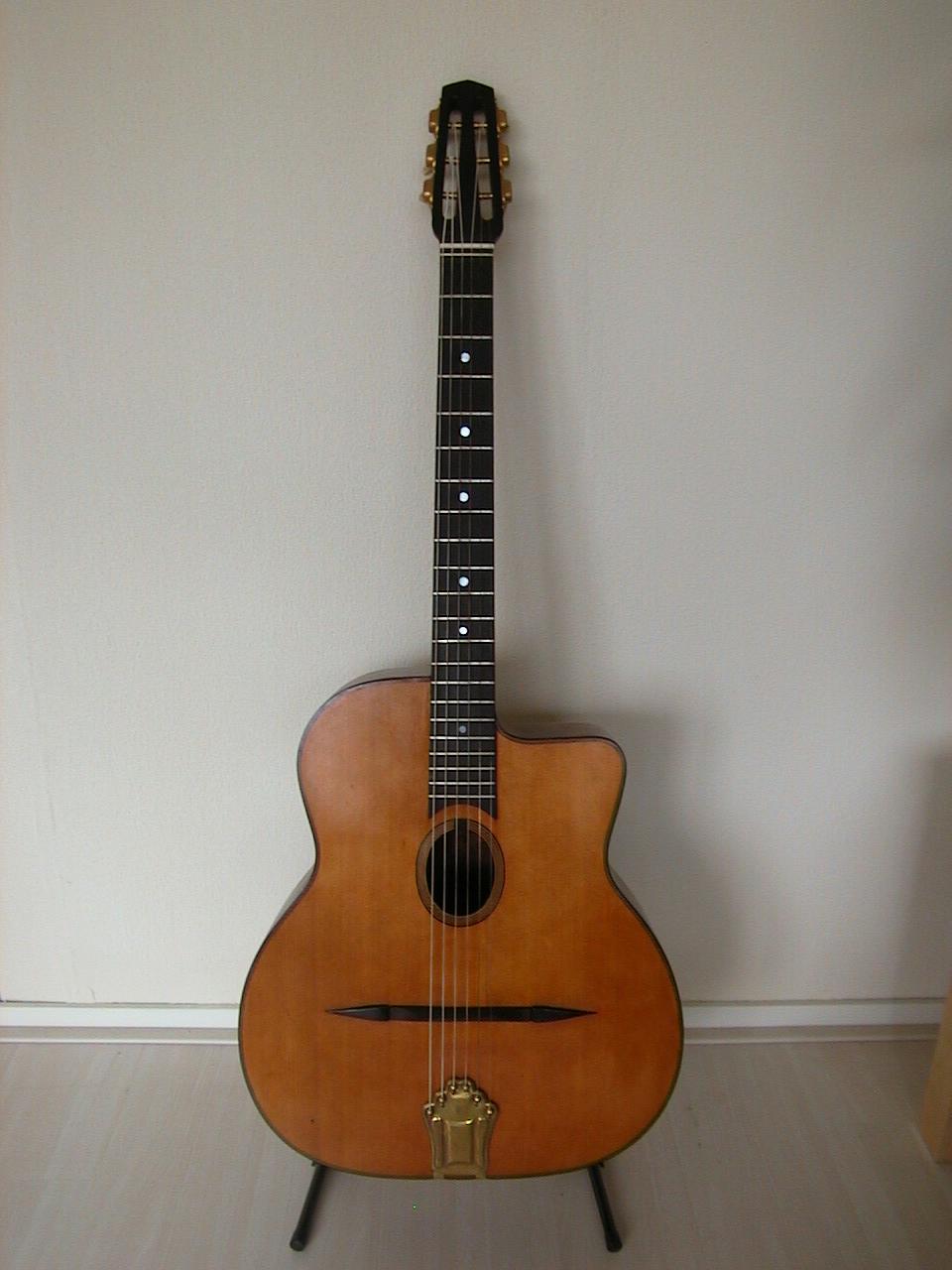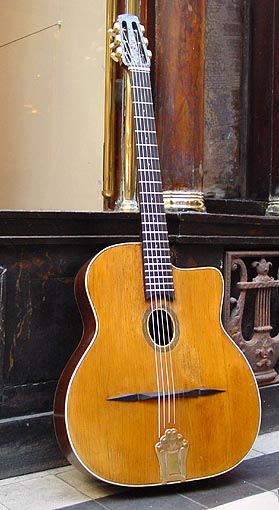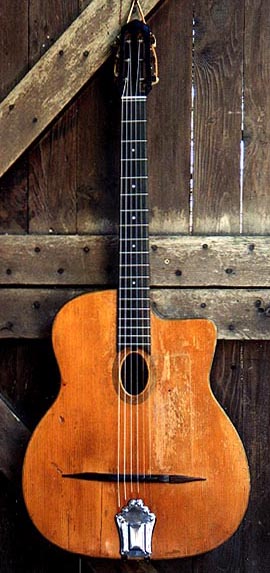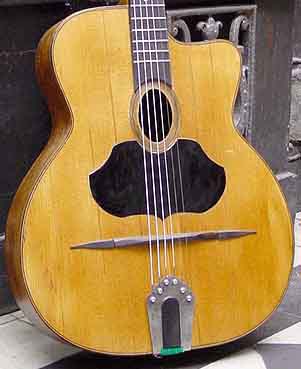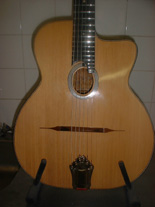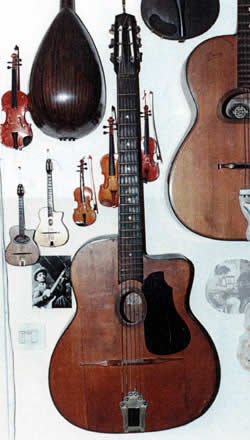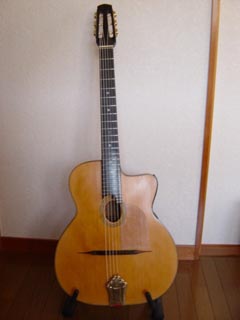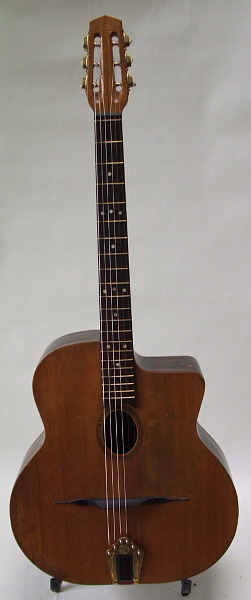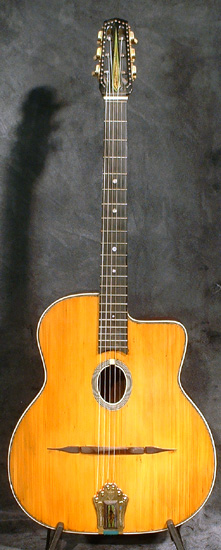Busato guitars
Main Jacques Favinos Jean-Pierre Favinos Other Favinos
I desparately need any information about the history of Busato that anyone is able to provide for the following sparse description. These guitars are important to Favino history because it may have been the Busato detour from the standard Selmer design that eventually inspired the Favino design to be architected.
For a long time nobody was even sure if there even was a person named "Busato" although it turns out that there was. He died in 1952, a year before Django. Information on Bernabe Busato and his shop is sketchy at best. At first we thought that it was just a name, because the workshop appeared to move frequently, or else there was more than one. There were also Busato accordeons being made at the same time crafted by another firm (Castagnolo? Fratelli Crosio?) and sold through Busato's shop with his name on them. He also made or sold banjos, basses, etc. Django was also photographed with a Carbonnell and owned a Busato.
Busatos are "usually" pretty good boxes. Bassy but light in tone, and they are without a doubt the lightest guitars I have ever played. Though extreme lightness is characteristic of French guitars from the day.
|
|
|
|
1939 Busato
Owner: Ger Boonstra
|
|
|
1940s Busato
Owner: Carmel Music
|
|
|
|
1940s Busato
Owner: Neil Andersson
|
|
|
|
|
1950s Busato
Owner: Jason Okamoto
|
|
|
|
|
|
Djangos Busato
Owner: private
|
|
|
|
1951 Busato
Owner: Jacques Mazzoleni
|
|
|
Busato D Hole
Owner: Patrick Bitane
|
|
|
Busato Oval Hole
Owner: Peter O'Connor
|
|
|
Busato Oval Hole
Owner: Private
|
|
|
Busato Oval Hole
Owner: Private
|
|
Busatos are one of the oldest lines of Selmer inspired guitars. Other vintage makers include - Favino, Carbonel, Olivieri, Gerome (Philippe Moneret), DiMauro, Castelluccia, Virente-Barcelonia, Burgassi, Couesnon and several others. Younger ateliers currently building Selmer inspired guitars include Aleman, Mazaud, Lebreton, Buro, Ducros, Pourtoy, Van Bergeikj, Roder, Hahl, Gose, Le Voi, Nonis, Hodson, Luomaranta, Gruen, Shelley Park, Leo Eimers and Feu Aile.
Players associated with Busato guitars include Django Reinhardt, Mondine and Ninine Garcia, Dorado Schmitt, jean-Phillipe Watremez, Romane, Fanto and Yayo Reinhardt.
There are a lot of Busatos in Europe and they are more common that they may seem. People will say 1940 , 1938 and so on, but on the label there is not date whatsoever. Busato had a "Petit model" and "Grand model" which, once translated, means simple model and deluxe model respectively. The simple model is mostly with a walnut back and sides. The top invariably made of French sapin ( spruce ) and the necks are noyer ( or walnut as well ) , and something which seems to be maple but it's more heavy and harder which Favino used as well. So there is a Petit model that was made after the war with no intricate inlays , but you recognize them with the woods used. The Grand model, which had either Brazilian Rio ( rosewood ) back and sides or maple back and sides, and which have some nice inlays most of the time. There is a picture above of the stripes at the back of neck, because it's the way that the maple ones were inlayed with a multilayered stripe, two green bindings surrounding a red one, to match the sides and top inlays/bindings . On the rosewood Grand models (invariably laminated brazilian rosewood but probably not Indian rosewood) , the neck is either exotic mahogany or rosewood. In these cases the stripe behind the neck is one piece of ebony (this before and after the war). On the headstock of these Grande models there was a small plate of metal, always aluminium (not likely to be brass). To recognize a Busato you may need to see the inside of the guitar, and not just to see the label or the woodblock that is sustaining the neck, but you need to recognize both the elements of construction and the bracing.
